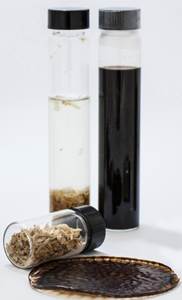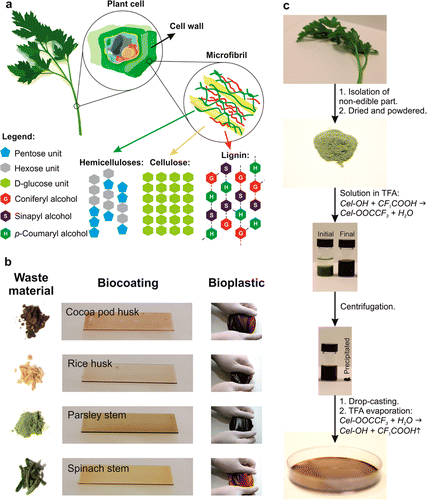变大米、欧芹和其他食品废物为生物降解塑料


科学家们现在报告,将来有一天,可可、稻米和蔬菜废物可能代替原油作为制造椅子、合成地毯和塑料袋等的原料。他们研发的新方法可以帮助世界解决农业和塑料垃圾问题,研究结果发表在ACS期刊《大分子》。
意大利技术研究所Athanassia Athanassiou、Ilker S. Bayer和同事指出,塑料用量不断增长。2012年,全世界的产量达到2.88亿吨,但它的普遍性是有代价的。持续数百或数千年的合成塑料会释放危害环境和人类健康的有毒成分。同时,塑料的原料是原油,原油是一种不可再生的资源。生产更环保的生物塑料具有挑战性,也更昂贵。Athanassiou的团队想找到简单、低成本地生产这种替代物的方式。
他们的目标是一种自然产生的可以处理纤维素的有机酸,纤维素是植物的主要建筑构件、也是自然界中最丰富的聚合物。他们将酸与欧芹、菠菜茎、稻壳和可可豆荚混合,然后,他们把所得到的溶液倒入实验盘。
测试时,形成的薄膜表现出从刚性易碎到柔和有弹性等系列特性——类似于商业塑料。“这开辟了用目前来自农业废物的生物塑料更换一些非降解聚合物的可能性,”研究人员总结。(编译:中国科学院成都生物研究所 王芋华,王海燕)
Direct Transformation of Edible Vegetable Waste into Bioplastics
Abstract Bioplastics with a wide range of mechanical properties were directly obtained from industrially processed edible vegetable and cereal wastes. As model systems, we present bioplastics synthesized from wastes of parsley and spinach stems, rice hulls, and cocoa pod husks by digesting in trifluoroacetic acid (TFA), casting, and evaporation. In this way, amorphous cellulose-based plastics are formed. Moreover, many other natural elements present in these plants are carried over into the bioplastics rendering them with many exceptional thermo-physical properties. Here, we show that, due to their broad compatibility with cellulose, amorphous cellulose can be naturally plasticized with these bioplastics by simply mixing during processing. Comparison of their mechanical properties with that of various petroleum based synthetic polymers indicates that these bioplastics have equivalent mechanical properties to the nondegrading ones. This opens up possibilities for replacing some of the nondegrading polymers with the present bioplastics obtained from agro-waste.
原文链接:http://pubs.acs.org/doi/pdfplus/10.1021/ma5008557

